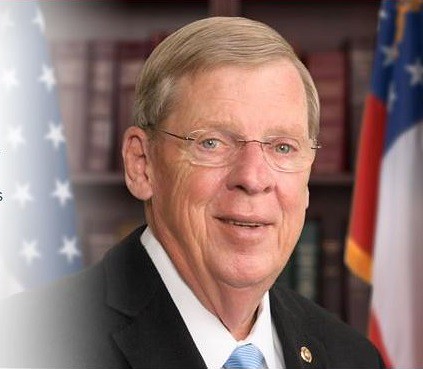
FOR IMMEDIATE RELEASE
Wednesday, February 1, 2017
Contact: Amanda Maddox, 202-224-7777
Kristen Hines, 202-228-2967
Isakson: Secretary of Veterans Affairs Must Improve Accessibility to Health Care
Highlights importance of bipartisan work of committee; goals for committee, VA secretary
WASHINGTON – In the first Senate Veterans Affairs Committee hearing for the 115th
Congress, U.S. Senator Johnny
Isakson, R-Ga., vowed that the committee will continue to work in the
bipartisan fashion that has allowed for past success during Isakson’s
tenure as chairman.
Isakson laid out his goals for reforming
the Veterans Choice program and significantly lowering wait times on
veterans’ appeals while continuing to work to empower veterans’
accessibility to health
care.
Isakson
committed to working together as partners with the U.S. Department of
Veterans Affairs (VA) to solve problems at the VA by looking at them
from every perspective to see to it that it’s
“the best health care system there can be for our veterans.”
During the hearing, called to consider
the pending nomination of David Shulkin, M.D., to be secretary of the
VA, Isakson called Shulkin the right person to head up the VA. Isakson
shared a personal
anecdote about Shulkin, who has served as under secretary for heath for
the VA since July 2015.
Isakson
described his first meeting with Shulkin, on a flight from Atlanta,
Ga., to Washington, D.C., where Shulkin introduced himself, and Isakson
requested that he contact a Georgia constituent who
had recently shared with Isakson concerns regarding the VA.
Describing the actions that occurred next, Isakson said,
“[When] I got to the office
the next morning, Dr. Shulkin had not only called [the constituent]
but… spent about three hours on the phone with him. I had a call from
Dr. Shulkin to let me know he talked to him and a call from the doctor
to let me know how
satisfied he was that Dr. Shulkin cared enough to call him.
“That’s what you look for – that’s the tender love and care that we look for in all executives that’s rarely ever there,”
Isakson continued.
“In a job like veteran’s
health care, that type of service and attitude is important. So, I also
want to remind David of what he did that day. That’s the day I knew if I
could cast a good vote for him, I would.”
Isakson opened today’s hearing by recognizing all of the veterans and Veterans Service Organizations in the room.
“You are the reason we’re here, to make sure we get the VA working as
efficiently as we can. And we thank you for your service to the
country.”
Isakson
went on to discuss his goals of helping ensure accessibility to health
care for veterans through the popular Veterans Choice program and
clarified that he has no intent of privatizing the department.
“We’re about making health care more available to veterans through implementation in the private sector and the [VA].” He emphasized,
“We don’t want to privatize it. We want to empower it.”
Isakson
also pointed to the great work left to be accomplished regarding the
length of wait times for appeals claims after helping ensure the choice
program is on-track.
“We have one goal that we have and that’s to get the wait time on appeals down. And I mean, way down.”
Isakson
encouraged the committee to work in conjunction with appropriators and
the VA to take all possible steps to speed up the process. He stated,
“I’m committed to accomplishing those two things in this two-year term on the committee.”
David
Shulkin, M.D., FACP, is board certified in Internal Medicine and a
Fellow of the American College of Physicians. Prior to serving as under
secretary for health for the VA, he was president of
Morristown Medical Center and president and CEO of Beth Israel Medical
Center in New York City.
###
The Senate Committee on Veterans’ Affairs is chaired by U.S. Senator Johnny Isakson, R-Ga., in the 115th Congress.
Isakson
is a veteran himself – having served in the Georgia Air National Guard
from 1966-1972 – and has been a member of the Senate VA Committee since
he joined the Senate in 2005. Isakson’s home
state of Georgia is home to more than a dozen military installations
representing each branch of the military as well as more than 750,000
veterans.
